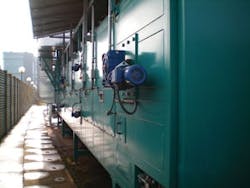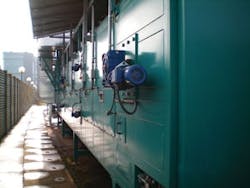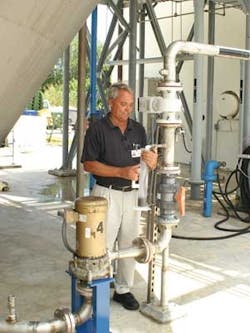Groundwater used for public supply contains contaminants, USGS study finds
RESTON, VA, May 21, 2010 -- More than 20 percent of untreated water samples from 932 public wells across the nation contained at least one contaminant at levels of potential health concern, according to a new study by the U.S. Geological Survey.
About 105 million people -- or more than one-third of the nation's population -- receive their drinking water from one of the 140,000 public water systems across the United States that rely on groundwater pumped from public wells
The USGS study focused primarily on source (untreated) water collected from public wells before treatment or blending rather than the finished (treated) drinking water that water utilities deliver to their customers.
"By focusing primarily on source-water quality, and by testing for many contaminants that are not regulated in drinking water, this USGS study complements the extensive monitoring of public water systems that is routinely conducted for regulatory and compliance purposes by federal, state and local drinking-water programs," said Matthew C. Larsen, USGS Associate Director for Water. "Findings assist water utility managers and regulators in making decisions about future monitoring needs and drinking-water issues."
Findings showed that naturally occurring contaminants, such as radon and arsenic, accounted for about three-quarters of contaminant concentrations greater than human-health benchmarks in untreated source water. Naturally occurring contaminants are mostly derived from the natural geologic materials that make up the aquifers from which well water is withdrawn.
Man-made contaminants were also found in untreated water sampled from the public wells, including herbicides, insecticides, solvents, disinfection by-products, nitrate, and gasoline chemicals. Man-made contaminants accounted for about one-quarter of contaminant concentrations greater than human-health benchmarks, but were detected in 64 percent of the samples, predominantly in samples from unconfined aquifers.
"Detections of contaminants do not necessarily indicate a concern for human health because USGS analytical methods can detect many contaminants at concentrations that are 100-fold to 1,000-fold lower than human-health benchmarks," said lead scientist Patricia Toccalino. "Assessing contaminants in these small amounts helps to track emerging issues in our water resources and to identify contaminants that may warrant inclusion in future monitoring."
Most (279) of the contaminants analyzed in this study are not federally regulated in finished drinking water under the Safe Drinking Water Act.
The USGS also sampled paired source and finished (treated) water from a smaller subset of 94 public wells. Findings showed that many man-made organic contaminants detected in source water generally were detected in finished water at similar concentrations. Organic contaminants detected in both treated and source water typically were detected at concentrations well below human-health benchmarks, however.
Additionally, the study shows that contaminants found in public wells usually co-occurred with other contaminants as mixtures. Mixtures can be a concern because the total combined toxicity of contaminants in water may be greater than that of any single contaminant. Mixtures of contaminants with concentrations approaching benchmarks were found in 84 percent of wells, but mixtures of contaminants above health benchmarks were found less frequently, in 4 percent of wells.
This USGS study identifies which contaminant mixtures may be of most concern in groundwater used for public-water supply and can help human-health researchers to target and prioritize toxicity assessments of contaminant mixtures. The USGS report identifies the need for continued research because relatively little is known about the potential health effects of most mixtures of contaminants.
Wells included in this study are located in 41 states and withdraw water from parts of 30 regionally extensive aquifers, which constitute about one-half of the principal aquifers used for water supply in the United States.
Human-health benchmarks used in this study include U.S. Environmental Protection Agency Maximum Contaminant Levels for regulated contaminants and USGS Health-Based Screening Levels for unregulated contaminants, which are non-enforceable guidelines developed by the USGS in collaboration with the EPA and other water partners.
Treated drinking water from public wells is regulated under the Safe Drinking Water Act. Water utilities, however, are not required to treat water for unregulated contaminants. The EPA uses USGS information on the occurrence of unregulated contaminants to identify contaminants that may require drinking-water regulation in the future.
This study and additional information about public wells can be found on the Quality of Water from Public-Supply Wells in the United States website >
People served by public water systems can obtain information about their drinking-water quality from their water supplier. Selected water suppliers provide an annual water-quality report; some reports are available on EPA's Consumer Confidence Reports (CRR) website >
Companion USGS studies http://oh.water.usgs.gov/tanc/NAWQATANC.htm on the transport of contaminants to public supply wells are online. In addition, a comparable study on the quality of water in domestic wells is online.
###


